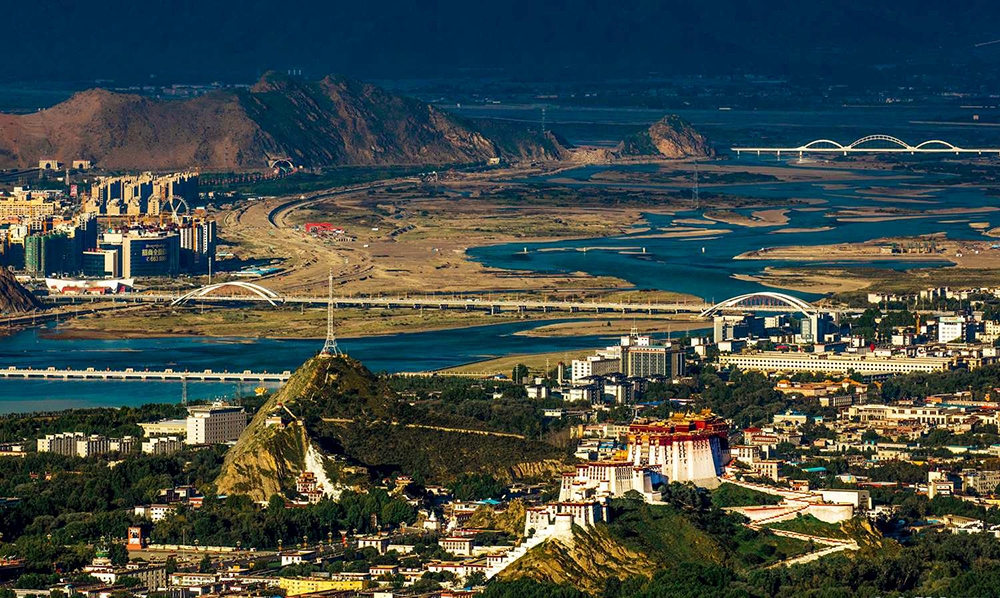Xi Focus: Xi's close bond with ethnic areas
Dawa Gyaltsen, a 37-year-old Tibetan herder, plans to build a family inn to host increasing tourists to his village near a national highway, thanks to the local annual peach blossom festival.
"My life is getting better and better," he said, bidding farewell to the hard life in his childhood. His family income from transportation, tourism cooperative dividends and herding exceeded 300,000 yuan (46,380 U.S. dollars) last year.
With increased income, Dawa Gyaltsen in Galai Village in the city of Nyingchi, southwest China's Tibet Autonomous Region, lives in a new house. His two children enjoy free education. Most of the medical fees of his parents can be covered by a rural healthcare program.
In July, President Xi Jinping, also general secretary of the Communist Party of China (CPC) Central Committee and chairman of the Central Military Commission, visited Dawa Gyaltsen's home and chatted with the family during his inspection tour of Tibet.
During the inspection trip, Xi said development in all sectors should focus on ethnic unity and progress, help improve people's livelihood and build consensus.
Xi attaches great importance to ethnic unity and the development of ethnic areas.
Guiding all ethnic groups to jointly strive for fully building a modern socialist country must be taken as a crucial task of the CPC's ethnic work in the new era, Xi said at the recent central conference on ethnic affairs held in Beijing.
COMMON DREAM
The Chinese nation is a big family and all of the family members shall live a good life, Xi has said.
Not a single ethnic group should be left behind in the efforts to fully build a modern socialist China, Xi said during his inspection tour of Qinghai Province in June. He said that the rejuvenation of the Chinese nation can be only achieved when all ethnic groups remain closely united like the seeds of a pomegranate that stick together.
In a historic feat, China, with a population of 1.4 billion, has eliminated absolute poverty and built a moderately prosperous society in all respects, with no one or single ethnic group left behind.
Before sunrise, Wang Deli, a villager in Maozhushan Village, Quanzhou County, south China's Guangxi Zhuang Autonomous Region, arrived at his vineyard and started picking grapes.
"The buyers come to the village in the morning, so I have to get the fruit ready before they come," Wang said.
His 0.8-hectare vineyard has brought him over 30,000 yuan in income so far, and when all grapes are sold, he is expected to earn more than 100,000 yuan this year.
While inspecting the local grape-growing industry in the village in April, Xi called for efforts to pursue rural vitalization based on local specialty industries. He also stressed measures that can ensure farmers benefit more from the development of rural industries.
Ethnic areas have accelerated efforts in fostering and promoting high-quality development, developing special industries and paying more attention to ecological conservation.
In 2020, these areas contributed more than 10 percent of the national GDP. From 2016 to 2020, these areas registered an annual GDP growth of 6.6 percent, 0.9 percentage points higher than the national rate, and created a total of 12.83 million urban jobs, or nearly one fifth of the country's total.
Cui Lijun, a Mongolian who lives in the Linhuangjiayuan Community in the city of Chifeng, north China's Inner Mongolia Autonomous Region, focuses on learning brushwork skills with calligraphy lovers.
Recently, the community organized activities such as Mongolian-Chinese bilingual calligraphy classes, encouraging residents to inherit excellent ethnic culture and boost ethnic solidarity.
During an inspection tour of Inner Mongolia Autonomous Region in July 2019, Xi visited Cui's community. He called for more efforts to promote ethnic unity and create a favorable environment where people of various ethnic groups can happily live and work.
Cui's community consists of residents from 13 ethnic groups. More than 1,300 families or 30 percent of the total community are comprised of two or more ethnic groups.
"The calligraphy class is a family of various ethnic groups. We have enhanced our friendship and enriched our lives through the learning and studying activities," Cui said.
Tibet Stories

A lot of changes and big hopes for the future
In 2012, I had the opportunity to go back to my hometown Shangri-La in Dechen, Yunnan, to su...

